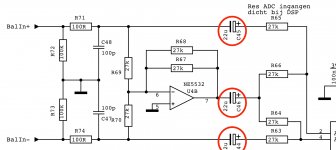The op amp removes common-mode input signals, notice the polarity inversion.
Bear in mind that the following circuitry could have DC voltages present.
Bear in mind that the following circuitry could have DC voltages present.
Last edited:
I wouldn't risk that unless you well understand the entire following circuit.
There are input voltage limits to the following IC, and also it could have DCV present
at its inputs, which could go back to the signal input.
There are input voltage limits to the following IC, and also it could have DCV present
at its inputs, which could go back to the signal input.
Last edited:
OK. There is a FPGA A/D -> D/A stage efter this. On the output of the FPGA there are again DC blocking non-polar lytics before the class-d amps.
//
//
One more thing - the driving unit is SE so BalIn is tied to ground I suppose. Has this some complication?
//
//
My wondering is... do the caps just only add DC protection for the A/D or do they have any other function?
The op amp will convert a single ended input to balanced.
The opamp creates a common mode reference, it does not convert bal to se. The opamp input is not the bal signal but the mid-point = common mode signal.
It is difficult to say anything about those caps because the circuit part where it matters is cut off ... But reflect: do you think that a manufacturer would put several capacitors on a PCB unless it is absolutely necessary?
Jan
Last edited:
If removed, do the circuit change function in any other way then letting thru DC?
Hard to say because you left out the circuit.
Jan
I did so because I though that knowing that the input circuit ended up in a FPGA was kind of setting the scene. I'm not asking for the whole thingy, just up to that 2-pole inlet... is that OK t ask like that?
//
//
Eventually I get a reply from Hypex on this - I started to think they didn't want to guide in such matters - but the statement was that the only thing they do is to block DC so shorting "works" but that it is not recommended.
So I will then try of course ;-D
And I will immediately find it superior, live with for a while, get worried, turn it back and find that I could not hear any difference ;-DD
//
So I will then try of course ;-D
And I will immediately find it superior, live with for a while, get worried, turn it back and find that I could not hear any difference ;-DD
//
The opamp creates a common mode reference, it does not convert bal to se. The opamp input is not the bal signal but the mid-point = common mode signal.
It is difficult to say anything about those caps because the circuit part where it matters is cut off ... But reflect: do you think that a manufacturer would put several capacitors on a PCB unless it is absolutely necessary?
Jan
Are you saying e.g. that the FPGA power feed / DC situation could have an impact (singel or +/- DC feed)?
One reason I can think of is robustness. Apparently this is made for professional audio in mind.
//
And I will immediately find it superior, live with for a while, get worried, turn it back and find that I could not hear any difference ;-DD
//
This is the great truth that all sufferers of audiophilia nervosa really should accept 😀
- Home
- Source & Line
- Analog Line Level
- Help! Understand circuit and mod?
